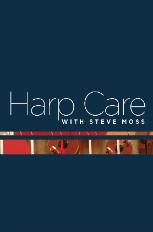Welcome to the second installment in a series of posts about pedal harp strings. In my last post, I discussed some of the structural differences between gut and nylon strings, and how these differences translate to differences in sound character. To recap, gut strings do not flex as much as nylon strings when played, resulting in a cleaner, more prominent fundamental pitch. Nylon strings stretch laterally when played, resulting in a more complex sound, with a weaker fundamental and a more prominent array of partial pitches or overtones.
This difference in elasticity also translates to a difference in intonation. In my opinion, the intonation of a string (i.e. how “in tune” the flat, natural, and sharp positions are, relative to one another) can be set more accurately with a gut string than a nylon string. In other words, in general, a harp that is strung in gut will play more in tune than one strung in nylon. Yes, it turns out that the extra expense of a gut string does make a difference. But this doesn’t mean everyone should string their harps in gut in every octave. There are other factors at work, which vary by octave. So let’s focus in on different areas of the harp.
From the fifth octave A through the third octave on any pedal harp, I HIGHLY recommend that all harpists use GUT strings. Why? First and foremost, they have a far superior sound over nylon strings. since nylon strings flex more, I believe they dissipate some of their playing energy, and lose their power to vibrate the harp’s soundboard as much as a gut string will. It is very difficult to get any volume out of a nylon string in these octaves, especially in the fourth and fifth octaves. If you try to play the string really hard, its elasticity will cause it to slap against a disc and cause a buzz, and if you play it mezzo forte or below, it won’t produce any sound.If you do play a nylon string hard enough to get some volume, all the extra lateral stretching I mentioned will mean prominent overtones, which will cloud the fundamental, meaning the pitch will sound like several pitches at once.
In addition, as I said, nylon strings cannot be regulated as accurately as gut strings, especially in the sharp position. With their greater tendency to stretch, nylon strings require a higher degree of grip, or twist, on the discs, to hold them in position. Greater disc grip translates to a sharper pitch, so the regulation on a nylon string in the third through fifth octaves will tend to be sharper than on the same harp strung in gut.
So, in my opinion, you do get what you pay for, and it is worth the extra money to use gut strings in the third, fourth, and fifth octaves. I don’t necessarily give the same advice for the first and second octaves, however. We’ll focus on those in the next post.



0 Comments